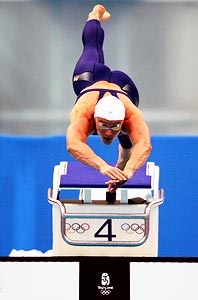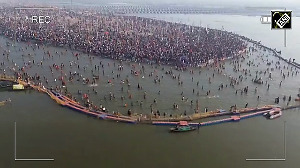Unless the Chinese accidentally used a faulty tape measure and built a 49-metre pool, there is no simple explanation for the glut of swimming world records set at the Beijing Olympics this week.
Records never last long in swimming but with 16 already wiped from the books in four days and plenty more expected to follow, the Water Cube is looking like the fabled river of gold.
- Special: Phelps, the Phenom
Plenty of theories have been posited, crediting superior training methods, better diets, the latest advancements in suit technology, custom-made pools that eliminate waves and reduce turbulence and even dolphins for teaching swimmers better ways to kick their legs underwater.
Few people agree on what is the single most important factor but the general consensus is that it is partly technological, partly psychological.
 "You have to have the barrier breakers," said US coach Eddie Reese. "I remember the four-minute mile being broken, by the time the year was out, five or six people had done it."
"You have to have the barrier breakers," said US coach Eddie Reese. "I remember the four-minute mile being broken, by the time the year was out, five or six people had done it."
The most popular theory for the flood of records in Beijing is the introduction of Speedo's new LZR suit, which was designed with help from US space agency NASA.
The suits keep swimmers in a corset-like grip allow them to maintain the best body position in the water for longer and reduce drag.
Independent scientists and even Speedo executives have been unable to provide any real evidence the suits do help but with more than 50 records falling to swimmers wearing them this year alone, almost everyone thinks it is no coincidence.
"I think the suit has changed things a little bit, but good people are great no matter what," US coach Jack Bauerle said.
Pools have come a long way in the past decade with designers using every trick to help produce super-fast times.
The Beijing pool is three metres deep, 50 centimetres more than at the last Games in Athens, and unlike older style pools where there was a deep end a shallow end, there is no variation in the water depth which reduces turbulence.
 The water on the sides of the pool spills on to the deck and drains away rather than flowing back into the pool. The racing lanes, once ropes, are now designed to stop waves crashing from one lane to the next.
The water on the sides of the pool spills on to the deck and drains away rather than flowing back into the pool. The racing lanes, once ropes, are now designed to stop waves crashing from one lane to the next.
The water is maintained at a constant temperature and treated with filters that improve visibility and cut the taste, smell and red eyes from chlorine, while the starting blocks are designed to help the swimmers, angled to give them a flying start.
"This is a very fast pool," said Bob Bowman, the personal coach of Michael Phelps.
"We also have the suits, which are helping. I think that combination of things has excited people.
"They're swimming more aggressively, they're taking a few more risks than before but I think what's changed so dramatically is peoples' expectations."








 © 2025
© 2025